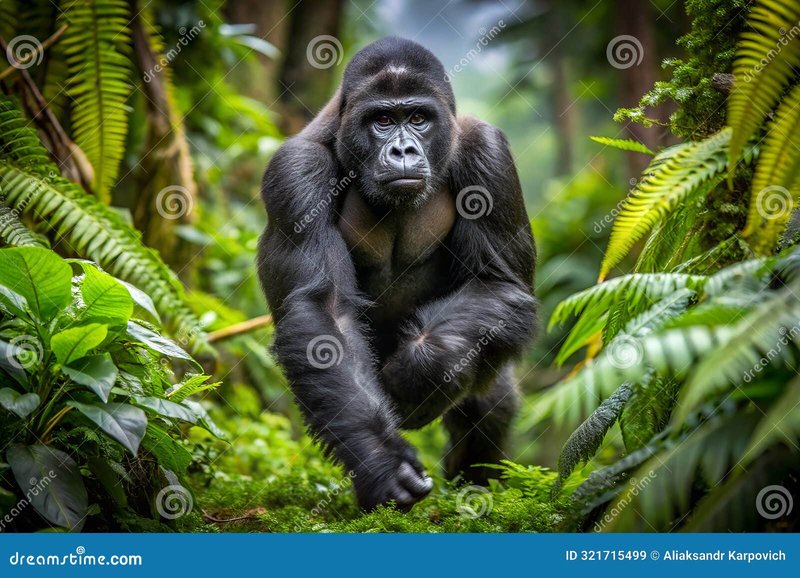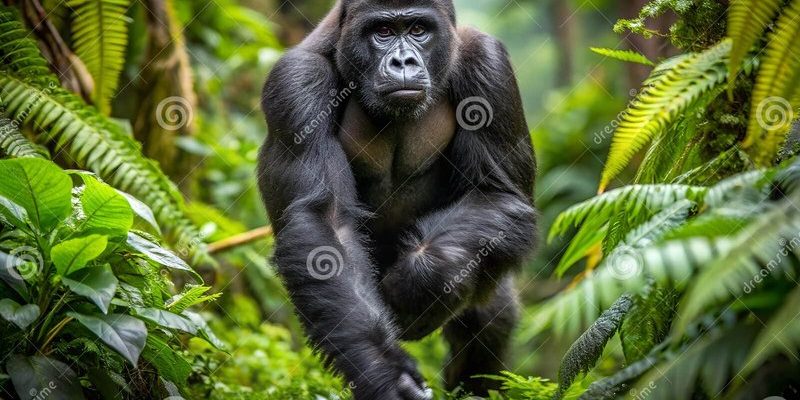
Imagine walking through a lush forest where every tree and plant has a story. The Eastern Gorilla, with its impressive presence, isn’t just another animal; it’s a key player in this vibrant narrative. As they move through their habitat, they help maintain the balance of their surrounding environment in surprising ways. Let’s dig deeper into how the Eastern Gorilla influences its ecosystem and why it matters to all of us.
1. The Role of Herbivores in the Ecosystem
Eastern Gorillas are primarily herbivores, munching on leaves, stems, and fruits. This diet plays a crucial role in maintaining the health of their forest home. As they feed, they help control the growth of certain plant species. If left unchecked, some plants might overgrow, blocking sunlight or taking nutrients from the soil that other plants need.
When gorillas eat, they also help disperse seeds. Imagine you’re snacking on berries and then dropping seeds as you walk—this is exactly what gorillas do! When they move from one place to another, they leave behind seeds that can grow into new plants. This not only promotes biodiversity but also shapes the forest’s structure, creating habitats for other species.
Furthermore, the gorillas’ choice of food impacts the entire ecosystem. By selectively eating specific plants, they can encourage the growth of others that provide food and shelter for different animals. This dynamic interaction is vital for the survival of countless species living in the forest.
2. Seed Dispersal: A Natural Process
One of the most fascinating aspects of the Eastern Gorilla’s role in its ecosystem is their talent for seed dispersal. When they consume fruit, the seeds pass through their digestive system unharmed. This process is crucial for the growth of various plant species because gorillas often travel considerable distances.
As they wander through their habitat, they essentially become mobile planting machines. The seeds get deposited in new areas, where they can germinate in fresh soil. This natural cycle aids in forest regeneration, ensuring that the ecosystem remains diverse and resilient over time.
You might wonder why this matters. Well, healthy forests help regulate the climate, support clean air, and provide habitats for numerous wildlife species. When gorillas do their job well, they indirectly boost the health of the entire ecosystem, benefiting everything from tiny insects to larger mammals.
3. Grazers and Competition: A Delicate Balance
In any ecosystem, balance is key. The Eastern Gorilla shares its habitat with other herbivores, like elephants and various antelope species. Each of these animals plays a unique role, and their interactions can create a complex web of competition and cooperation.
Gorillas primarily feed on understory plants, leaving some of the taller vegetation for elephants or other grazing animals. This division of resources ensures that all species have enough to eat. If one species becomes too dominant, it can lead to food shortages for others.
By maintaining this balance, Eastern Gorillas help prevent overgrazing. Their presence supports the growth of diverse plant life, which, in turn, supports other animals. This interconnectedness is what keeps ecosystems thriving, and it’s a beautiful reminder of how important every creature is—no matter the size.
4. Gorillas as Indicators of Ecosystem Health
You might be surprised to learn that Eastern Gorillas serve as indicators of ecological health. Because they require specific habitats rich in vegetation, any changes in their population can signal shifts in the ecosystem. If their numbers decline, it often points to problems such as deforestation, poaching, or climate change.
When scientists study gorilla populations, they can gather valuable insights into the overall health of their environment. For instance, a flourishing gorilla population typically suggests a well-balanced ecosystem. On the other hand, a decline could highlight issues that need addressing.
This connection means that protecting Eastern Gorillas isn’t just about saving one species; it’s about preserving the entire ecosystem. By supporting conservation efforts and creating awareness, we can help maintain the health of the forest for generations to come.
5. The Threats Facing Eastern Gorillas
Unfortunately, Eastern Gorillas face numerous threats that jeopardize their role in the ecosystem. Habitat loss due to logging, agriculture, and human encroachment puts pressure on their populations. As forests vanish, so do the resources these gorillas rely on.
Poaching is another serious issue. Gorillas are hunted for their meat or captured for the illegal pet trade. These actions disrupt the delicate balance of the ecosystem, as fewer gorillas mean less seed dispersal and reduced biodiversity.
Conservation groups are working tirelessly to combat these threats, but it’s a challenging battle. By raising awareness and supporting local initiatives, we can all contribute to ensuring Eastern Gorillas continue to thrive in their natural habitat.
6. Conservation Efforts and Their Importance
In recent years, conservation efforts have gained momentum to protect Eastern Gorillas and their ecosystems. Initiatives include establishing protected areas, promoting sustainable agriculture, and raising public awareness about the importance of these majestic creatures.
Creating national parks where gorillas can roam freely is critical. These parks not only protect the gorillas but also conserve the rich biodiversity of the forest. By encouraging eco-tourism, local communities can benefit economically, which helps promote a culture of conservation.
Supporting research is also vital. Understanding gorilla behaviors and their interactions within the ecosystem can help refine conservation strategies. As we learn more about their role, we can better protect them and the habitats they depend on.
7. A Call to Action: Protecting Eastern Gorillas Together
Our planet is full of incredible species like the Eastern Gorilla, and they all play essential roles in the tapestry of life. Protecting these animals means safeguarding the ecosystems they inhabit, which ultimately benefits us all.
You might be wondering how you can help. Simple actions, like supporting sustainable products, donating to conservation organizations, or educating yourself and others about gorillas, can make a difference. Every effort counts!
Together, we can ensure that Eastern Gorillas continue to thrive in their natural habitats, playing their part as nature’s gardeners while inspiring future generations to cherish and protect our planet.
In conclusion, the Eastern Gorilla’s role in its ecosystem is multifaceted and crucial. They help maintain the balance within their environment, contribute to biodiversity, and serve as indicators of ecological health. By understanding and supporting their conservation, we ensure that the intricate web of life they belong to remains vibrant and resilient. Remember, every creature has a purpose, and together, we can make a significant impact.

